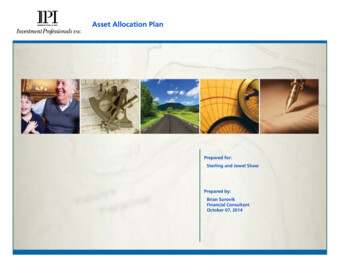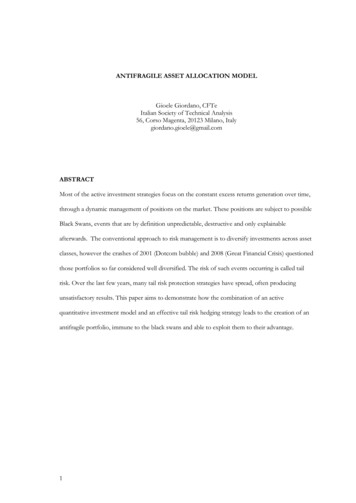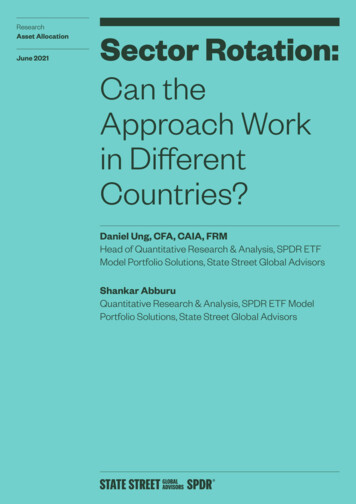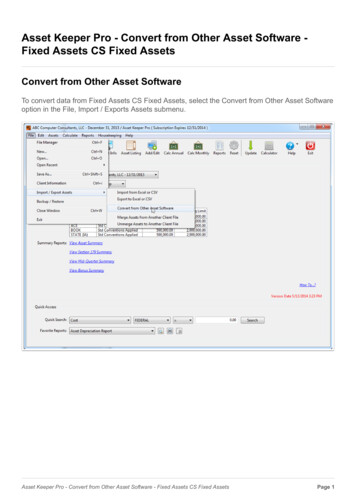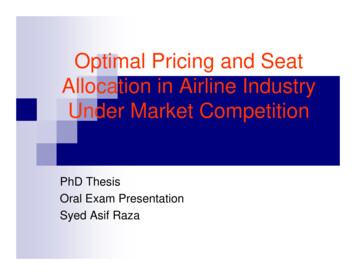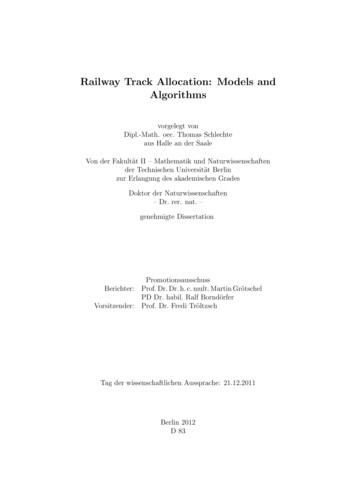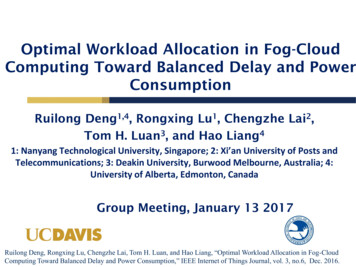
Transcription
Asset Allocation:Analysis of Theory and Practicein the Australian Investment Management IndustryThesis submitted in fulfilment of the requirementsfor the degree of Doctor of PhilosophyLujer SantacruzMFinPlan, MBusMgt, BScMEngSchool of CommerceFaculty of Business Education Law and ArtsUniversity of Southern QueenslandToowoomba Queensland 4350 Australia2015
Asset Allocation: Analysis of Theory and PracticeTable of contentsAbstract . vCertification of thesis . viAcknowledgements . viiList of figures . viiiList of tables . ixChapter 1: Introduction and aims . 11.1 Background . 11.2 Research objectives . 21.3 Main research question . 21.4 Motivation for the research . 21.5 Expected contribution of the research . 21.6 Structure of the thesis . 4Chapter 2: Literature review surveying asset allocation theories. 52.1 Modern Portfolio Theory (MPT) . 52.1.1 Historical background . 52.1.2 Markowitz mean-variance model of asset allocation . 62.1.3 Limitations and practical difficulties with the original mean-variance model . 92.2 Modern Portfolio Theory subsequent research strands . 92.2.1 Use of additional parameters . 92.2.2 Use of risk measures other than variance of expected returns . 112.2.3 Addressing parameter uncertainty . 172.2.4 Multi-period models. 222.2.5 Non-quadratic utility function models . 252.2.6 Other asset allocation models . 26ii
Asset Allocation: Analysis of Theory and Practice2.2.7 Inclusion of alternative assets in the model . 302.2.8 Portfolio Separation Theorem and extension of MPT to asset pricing . 312.2.9 Non-finance applications of Modern Portfolio Theory. 34Chapter 3: Literature review on asset allocation theory-practice dichotomy . 35Chapter 4: Research questions and proposed conceptual model . 394.1 Research question and sub-questions . 394.2 Conceptual model . 394.3 Research hypotheses . 45Chapter 5: Research methodology . 475.1 Dimensions of the present research . 475.2 Use of survey research methodology in finance . 475.3 Survey structure . 48Chapter 6: Overview of the Australian investment management industry . 506.1 Introduction. 506.2 Superannuation or pension funds. 506.3 Fund managers . 516.4 Asset consultants to institutional investors . 536.5 Personal financial planning groups . 536.6 Insurance companies . 546.7 Savings or investment banks . 55Chapter 7: Data gathering study number 1 – survey of academics . 567.1 Introduction. 567.2 Research instrument. 577.3 Analysis of respondent profile . 597.4 Results and discussion . 617.5 Chapter summary . 66iii
Asset Allocation: Analysis of Theory and PracticeChapter 8: Data gathering study number 2 – interviews of practitioners . 678.1 Introduction. 678.2 Research instrument. 688.3 Analysis of respondent profile . 698.4 Results and discussion . 698.5 Chapter summary . 81Chapter 9: Data gathering study number 3 – survey of practitioners . 838.1 Introduction. 839.2 Operationalisation of constructs used in the conceptual model. 849.3 Research instrument. 909.4 Sample design and data collection . 969.5 Analysis of respondent profile . 989.6 Results and discussion . 1029.7 Chapter summary . 118Chapter 10: Conclusions . 121List of references . 128iv
Asset Allocation: Analysis of Theory and PracticeAbstractAsset allocation is the decision on how much of the investment portfolio to place in each ofthe broad asset classes (e.g. cash, fixed interest securities, property, equities). It is a keydecision area in the investment management industry, where professional investors managepooled investments.The present research examined any dichotomy between theory andpractice of asset allocation in the Australian investment management industry. It surveyed theavailable body of research on asset allocation consisting of Modern Portfolio Theory from theseminal Markowitz mean-variance formulation to subsequent research strands. It utilised acombination of qualitative and quantitative methods to examine the level of awareness andusage of asset allocation theories and theory-based methods among investment managementindustry practitioners. The present research established that while there is a high level ofawareness, there is a low level of usage of asset allocation theory and theory-based methods inthe industry. Structural Equation Modelling identified perceived usefulness as having thestrongest influence on usage. Recommendations mostly revolving around improving theinteraction between academe and industry are made that may help reduce the theory-practicedichotomy. Limitations of the present research are discussed as well as future areas for relatedresearch.v
Asset Allocation: Analysis of Theory and PracticeCertification of thesisI certify that the work reported in this thesis are entirely my own effort, except whereotherwise acknowledged. I also certify that the work is original and has not been previouslysubmitted for any other award, except where otherwise acknowledged.Lujer Santacruz5 November 2015DateSupervisors’ endorsement:Chandrasekhar Krishnamurti5 November 2015DateFrank Elston5 November 2015Datevi
Asset Allocation: Analysis of Theory and PracticeAcknowledgementsI am very grateful to my wife Bella and daughter Maria who have served as both motivationand inspiration for me throughout my PhD undertaking.I am thankful to my PhD supervisors Prof Chandrasekhar Krishnamurti and Dr Frank Elstonfor their guidance and constructive feedback. I am thankful to my USQ colleagues whoreviewed and provided suggestions on my PhD research proposal as panellists: AssociateProfessor Peter Phillips who was also the one who suggested the research topic to me,Associate Professor Joseph Mula who also provided valuable comments on the first draft ofthe complete thesis and Professor Julie Cotter who also introduced me to Research Methods.I am grateful to Nobel Laureate Prof Harry Markowitz, who was largely responsible fororiginating the body of knowledge on portfolio optimisation which is the subject of this thesis.I greatly admire his generosity in sharing his valuable time and his insights with me when Imet with him over an extended lunch in San Diego on 15 November 2012.vii
Asset Allocation: Analysis of Theory and PracticeList of figuresFigure 1Size and scale of Australia’s investment management industry3Figure 2The set of all risky portfolios from which an investor may choose7Figure 3The set of optimal portfolios or the efficient frontier8Figure 4The mean-variance efficient frontier with a VAR constraint14Figure 5The mean-variance efficient frontier with a CVAR constraint15Figure 6Gain-loss analysis28Figure 7Portfolio Separation theory32Figure 8The risk-reward trade-off33Figure 9The Security Market Line34Figure 10The Marketing Model40Figure 11The Technology Acceptance Model41Figure 12The Theory of Planned Behaviour41Figure 13The proposed conceptual model44Figure 14The conceptual model83Figure 15The sampling approach utilised and the valid response rates98Figure 16Results of Confirmatory Factor Analysis109Figure 17Results of SEM using the conceptual model110Figure 18Results of SEM using the expanded conceptual model112Figure 19Results of SEM using the modified conceptual model113viii
Asset Allocation: Analysis of Theory and PracticeList of tablesTable 1Studies applying MPT to other areas34Table 2Survey studies on theory and practice in various areas of Finance37Table 3The 50 largest superannuation funds in terms of assets50Table 4The 30 largest fund managers in terms of funds under management52Table 5The major asset consultants53Table 6The 30 largest financial planning groups in terms of number of advisers54Table 7The 20 largest insurance companies in terms of market share54Table 8Survey instrument for Study number 157Table 9Distribution of respondents by country59Table 10Distribution of respondents by research focus60Table 11Comparison of h-indices of respondents and non-respondents61Table 12Responses to question on importance of theory categories62Table 13Testing responses to question on importance of theory categories for bias 63Table 14Top mentions among other asset allocation models64Table 15Comments about asset allocation in general65Table 16Interview questions used in Study number 268Table 17Responses to interview question 169Table 18Responses to interview question 271Table 19Responses to interview question 372Table 20Responses to interview question 473Table 21Responses to interview question 574Table 22Responses to interview question 675Table 23Responses to interview question 7
Table 14 Top mentions among other asset allocation models 64 Table 15 Comments about asset allocation in general 65 Table 16 Interview questions used in Study number 2 68 Table 17 Responses to interview question 1 69 Table 18 Responses to interview question 2 71 Table 19 Responses to interview question 3 72 Table 20 Responses to interview question 4 73 Table 21 Responses to interview File Size: 1MBPage Count: 153



